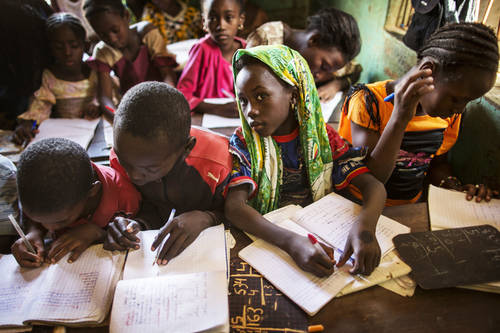$2.3 billion required to send children to school in war-torn countries
A new paper by UNESCO’s Education For All Global Monitoring Report (EFA GMR) shows that 34 million children and adolescents are out of school in conflict-affected countries. The most vulnerable are the hardest hit: the poorest are twice as likely to be out of school as their counterparts in peaceful countries. The paper shows that $2.3 billion is required to place them in school - ten times the amount that education is receiving from humanitarian aid right now.

School children in a classroom in Gao, Mali
The EFA GMR’s last report showed that only a third of countries had reached global education goals set in 2000, and identified conflict as one of the major barriers to achieving better results. The paper shows the extent of the challenges that conflict presents. Children in conflict-affected countries are more than twice as likely, and adolescents two-thirds more likely, to be out of school than in non-conflict affected countries. Young women are almost 90 per cent more likely to be out of secondary school in conflict affected-countries than elsewhere.
“Returning to school may be the only flicker of hope and normality for many children and youth in countries engulfed in crises,” said Irina Bokova, Director General of UNESCO. “The Incheon Declaration adopted by 160 countries commits to meeting the needs of these populations through more resilient, resistive and inclusive education systems and a response to crisis that spans the phases of emergency, recovery and building. Education must be seen as part of the first response when crisis hits and an integral part of any peacebuilding strategy.”
One of the core reasons conflict is taking such a heavy toll on education is lack of financing. In 2014, education received only two per cent of humanitarian aid. The paper determines that even the suggested target of four per cent, championed since 2011, is insufficient. Had this target been met in 2013, it would have left 15.5 million children and youth without any humanitarian assistance in education.
Aaron Benavot, Director of the EFA GMR, said: “A new target for directing funds to education in times of conflict has been required for some time. Present targets are hugely insufficient and diverting attention from the true needs of children and youth on the ground. For primary education, an extra $38 is needed per child in conflict situations. $113 is needed per adolescent in lower secondary education. Surely we can find these funds. Most of us carry the cost for one child in our pocket.”
Media attention unfairly prioritizes some countries over others: more than half of available humanitarian aid to education was allocated to just 15 out of 342 appeals between 2000 and 2014.
Many appeals do not cover all those in need. In 2013, 21 million people in conflict-affected zones were identified as requiring education support. Just eight million were included in appeals. Of those, just three million received assistance once funding was distributed – leaving 18 million without any help at all.
The paper proposes a new, evidence-based finance target, and makes recommendations for tightening the current aid structure for education in crises:
● There must be a consistent and objective education needs assessment to truly understand the requirements of children and adolescents in conflict.
● There should be better connections between humanitarian and development financing: The World Humanitarian Summit in July 2016 together with a High-Level Panel on Humanitarian Financing to be formed later in 2015 represent opportunities to make the architecture of humanitarian funding more relevant and realistic.
● The $2.3 billion funding gap for education in conflict, which is ten times more than education currently receives from humanitarian aid, urgently needs to be filled.
● Any new global emergency education fund should ensure that resources for education in crises are additional, flexible and predictable. Funding must be aligned to need. It should work closely with the Global Partnership for Education and the Global Education Cluster.
Source: United Nations Educational Scientific and Cultural Organization
- 290 reads
Human Rights
Ringing FOWPAL’s Peace Bell for the World:Nobel Peace Prize Laureates’ Visions and Actions

Protecting the World’s Cultural Diversity for a Sustainable Future

The Peace Bell Resonates at the 27th Eurasian Economic Summit

Declaration of World Day of the Power of Hope Endorsed by People in 158 Nations

Puppet Show I International Friendship Day 2020

